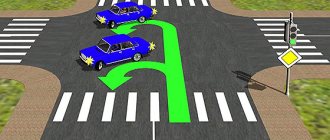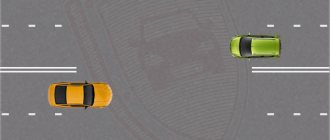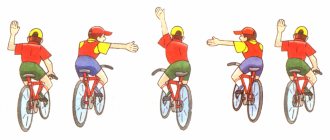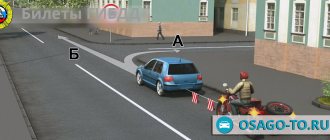Changing lanes does not raise any questions for experienced drivers. When driving on the highway and in dense city traffic, maneuvers occur automatically. An unintentional or forced violation of traffic rules may result in a fine or a traffic accident. Avoiding problematic situations will allow mutual respect between traffic participants and an understanding of when there is no need to take risks.
What is rebuilding?
Changing lanes is a maneuver in which a car leaves a previously occupied lane while maintaining the direction of travel. It is carried out taking into account the markings on the highway, which causes difficulties for drivers in difficult weather conditions and on bad roads where there are no directional signs. A ban on changing lanes is established using demarcation stripes on the road surface:
- Single continuous marking. Separates opposing flows and marks boundaries in dangerous places. In addition, it demarcates parking areas and areas for which entry is prohibited. Permanent solid stripes are marked with white paint, temporary stripes are marked with orange. To systematize the flow in one direction, a continuous line in the same direction is drawn on the road.
- Double solid line. Traffic controller on a road with 4 or more lanes (for example, 2 on each side). Crossing it in order to change lanes or turn around in the wrong place creates a dangerous situation.
- Single solid marking with a satellite - a dotted line on the left. Indicates areas where changing lanes is allowed only on one side.
- Wide continuous stripe. Indicates the edge of the roadway.
Where can you change lanes and where is it prohibited?
Changing lanes causes anxiety among inexperienced drivers. However, there are situations where even an experienced motorist may doubt the correctness of actions. The main taboo on changing lanes is regulated by a solid line, which is found in tunnels, in the area of bridges, sharp turns and bends. To avoid causing an accident and losing your license, the driver must pay attention to the marking lines and know when he has the right of way.
In the tunnel
Throughout the tunnel, the road lanes are divided by solid lines, which vetoes lane changes. It operates on Russian highways and is explained by the difference in temperature conditions. During the cold season, it is warmer in the tunnel than outside. As a result, when driving from a cold area to a warm one, wheel traction deteriorates, which leads to emergency situations when trying to maneuver.
Before driving through the tunnel, motorists are advised to decide on their lane. If the opportunity is missed, you need to change lanes after leaving, when the solid markings are replaced by dotted lines.
On Bridge
The rules do not contain information about the prohibition of changing lanes from one lane to another while crossing bridges. However, overtaking is strictly prohibited. If the driver needs to change lanes, he can do this without subsequently returning to the original lane and only in those places where this is permitted by markings (there is no continuous line).
On the ring
When traveling in this area, motorists must follow the rules for driving around roundabouts. You can change lanes if there is no continuous line on the road. During the maneuver, you should give way to vehicles driving directly in the adjacent lane.
At the crossroads
Controlled and unregulated intersections are complex sections of the road. When changing lanes, you need to give way not only to cars, but also to pedestrians and cyclists who follow the intended path. The rules do not prohibit changing lanes when entering intersections, and experienced drivers make the maneuver in advance. If you need to change lanes in a difficult area, you should remember the priority of vehicles moving on the right.
Traffic regulations (clause 11.4) prohibit overtaking on such sections of roads. However, it is difficult to do without it when changing lanes, so the best option would be to move in advance to the lane you are interested in:
- to move right/left – to the far right/left lane;
- to continue straight movement - on any path, taking into account the traffic light arrows.
At a pedestrian crossing
The rules do not prohibit changing lanes in this place, however, overtaking is strictly prohibited. An unsuccessful maneuver can threaten the health of pedestrians and impede their movement (stopping a car at a zebra crossing). In order to avoid nagging from traffic police officers and accidents, it is advisable to change lanes outside the crossings.
Overtaking and getting ahead at a pedestrian crossing - what do you need to know?
What fines are imposed on drivers for overtaking and speeding at zebra crossings?
A pedestrian is much more vulnerable than a person driving a car. After all, in the event of an unforeseen situation, he will not be able to move fast enough. For the safety of people, special communications are created: sidewalks, pedestrian paths and crossings (“zebra crossings”). Traffic regulations require drivers to drive in their locations with extreme caution.
Overtaking is rightfully considered the most difficult maneuver. Every year, thousands of people die under the wheels of cars as a result of incorrect actions by drivers during lane changes. Overtaking, by the way, can be no less dangerous if you neglect the Rules of the Road. Does the law allow maneuvering at zebra crossings? What sanctions will face a motorist who violates traffic rules at a pedestrian crossing?
Terminology and maneuvering procedures
Leading is considered to be driving in the adjacent lane in the same direction at a speed greater than that of the second vehicle. In this case, driving into oncoming traffic never occurs. Of course, the maneuver is only possible on a road that has at least two lanes for driving in one direction.
Overtaking, in essence, is also getting ahead of one or more cars. The only difference is that this maneuver requires a short-term movement into the lane intended for oncoming traffic. After the overtaken car remains behind, the driver returns to his original position on the roadway.
Image source: kolesa.ru
The procedure for performing maneuvers related to advancing is regulated by section 11 of the Road Traffic Rules. The rule states that overtaking at a pedestrian crossing is unacceptable. Several years ago, traffic regulations allowed this maneuver on a zebra crossing provided there were no people on it. However, legislators considered that allowing drivers to enter the oncoming lane in such a dangerous place was risky. Today, overtaking at a pedestrian crossing is completely prohibited.
Things are a little different with advances. The motorist has the right to do it, even if the trajectory intersects with a zebra crossing. In this case, the driver must rely on paragraph 14.2 of the traffic rules. The norm states that the driver is obliged to monitor whether another vehicle has stopped before the crossing. Even behind a small car, you may not notice a person walking across the road. Therefore, if someone brakes in front of a zebra crossing, you need to reduce your speed as much as possible. Only after making sure that there are no people on the roadway can you resume driving to get ahead of another car.
Nuances you need to know about
It is important to understand where the boundaries of the pedestrian crossing are. Conventional markings are not always applied to asphalt. If it is there, then the width of the zebra corresponds to the width of the white stripes. If there is no marking, the beginning of the pedestrian zone will be considered the line on which sign 5.19.1 is installed. Accordingly, the transition will end where sign 5.19.2 is located.
It does not matter whether the zebra crossing is located in a populated area or outside the city. The maneuvering procedure is the same in all cases.
If a driver begins to overtake in front of a pedestrian crossing, he must have time to return to his lane before approaching it. It is important to be able to not only change lanes in time, but also slow down in advance. After all, it is impossible to predict whether people will end up on the roadway. If the zebra has just been left behind, you can begin the maneuver immediately. The main thing is to make sure that there are no signs on the road prohibiting this.
Image source: au71.ru
Types of punishment
Penalties for overtaking at a pedestrian crossing are provided for in Part 4 of Article 12.15 of the Code of Administrative Offenses of the Russian Federation. According to this standard, a driver who violates traffic rules may face two types of punishment: a fine (5,000 rubles) or deprivation of rights for 4-6 months. If the offense is committed again, the motorist will not be able to drive for one year. The only exceptions are cases of detection of violations using “tripods” or stationary cameras. If the act is photographed or videotaped, the driver will be fined again in the amount of 5,000 rubles.
If traffic rules are violated while crossing a zebra crossing, the sanctions will be different. In this case, the traffic police inspector will draw up a protocol against the motorist under Article 12.18 of the Code of Administrative Offenses of the Russian Federation. For failure to give the right of way to a pedestrian crossing the road, the driver will have to pay a fine to the state treasury. In 2021, its size may range from 1,500 to 2,500 rubles.
Most pedestrians expect that people will give way to them at the crossing. People sometimes lose their vigilance, feeling safe on the zebra crossing. This should be understood by those who drive. Then the number of victims on the roads will decrease significantly.
Interested in the topic of cars and traffic rules? We recommend the website of our colleagues - MotorsGuide.ru.
Source: https://www.RuDorogi.ru/articles/traffic-laws/overtaking-advancing-pedestrian-crossing.html
Rules for changing lanes
Information about changing lanes is set out in paragraph 8.4 of the Traffic Rules. The driver's action algorithm is simple:
- make sure you can maneuver;
- turn on the turn signals;
- must give way to vehicles moving in the required lane without changing direction;
- parallel cars on the right;
- smoothly reduce speed and calculate the distance to the nearest cars;
- take into account the speed of transport moving in an adjacent direction.
In practice, not all motorists maneuver correctly, resulting in a dangerous situation or collision. Information on how to behave in different traffic situations will help you avoid problems.
Mutual
When changing lanes at the same time, drivers have a lot of disputes. For example, when deciding what should do when maneuvering on a three-lane road. One car is driving in the far left lane and starts changing lanes into the middle one. The other seeks to get into the middle row from the far right lane.
According to the rules, in this case the driver of the car on the right has the advantage. To avoid lateral contact, the driver on the left must slow down and let cars on the right and vehicles that have changed lanes pass. It is important to take into account the behavior of other participants.
Between the rows
Such a maneuver is considered dangerous, especially for novice drivers. The restructuring should be done gradually and in advance. For example, when driving on a three-lane highway, changing from the far right or left lane to the opposite lane should be done in 2 stages, from row to row. First you should take the middle lane, and then move to the desired row. In this case, the pace of movement of other road users should be taken into account.
It is prohibited to cross 2 dividing lines at once during one lane change.
When there is interference on the right
This situation means that a car is moving to the right of the driver who plans to change lanes. You should skip it and only then carry out the maneuver. In the event of a mutual change of lanes, there is no interference, however, transport on the right has priority. If the question concerns a situation where a driver is moving on the left side, and a car on the right is changing lanes into his lane, you need to ignore the obstacle and only then change lanes yourself.
To the left lane
In this case, you need to rebuild correctly according to the general rules. The motorist should turn on the turn signal, slow down and let cars moving straight in the left lane pass. After this, you can begin rebuilding. The type of road (main, secondary) does not matter. The one who plans to rebuild always gives in. If they pass him by out of politeness, you can seize the moment.
Before the traffic light
It happens that motorists make the decision to change lanes before a traffic light. This happens, for example, if the far right lane is occupied and the green signal is on. You should act according to the general rules, but taking into account the following nuances:
- mandatory inclusion of turn signals (despite the absence of cars moving in the same direction);
- if the prohibitory signal is on, you must stop in front of the traffic light;
- When changing lanes, there is no need to specifically slow down the speed; you should maintain its average value.
When the road narrows
A sign warns in advance about the reduction of lanes on the highway. In this case, drivers should move in advance to the lane that will continue. In this case, the advantage of movement remains with cars moving along a non-constricted path. They must continue at the same speed. When changing lanes, you should let them pass and then make the maneuver.
Public transport
Rebuilding of trolleybuses, buses, and trams occurs according to general rules. If public transport moves along the lane that is allocated for it, then cars are allowed to occupy it when it is safe to change lanes or turn left.
However, the maneuver should be carried out promptly so as not to impede the traffic for which the lane is intended.
Mutual lane change according to traffic rules
Mutual lane changes in sections of traffic rules are not considered separately, which means that they are carried out as prescribed in paragraphs 8.1 and 8.4. But there may also be nuances here:
- The need to move two cars into one lane. If car A is moving from the far left through the center to the right, and at this time car B is maneuvering from the right to the middle, the driver must yield first.
More on AutoLex.Net:
Main and secondary causes of road accidents
Here the requirement of clause 8.4 of the “Rules...” must be met.
- The need to maneuver through several lanes. If the car needs to move from one extreme to the other through the center, all areas should be monitored. Because the requirement to give way to those driving straight along a constant trajectory and those approaching from the right is not canceled. An important detail of the action: the turn signal must be turned on until the car is in the right place.
The maneuver in question before the intersection may also be difficult. It is allowed here, because we are not talking about overtaking, but just moving to the next lane. The rules are the same: yield to the next in the row strictly straight ahead and to the cars on the right. But the driver needs to be especially careful and try to complete the action before entering the intersection. Otherwise, vehicles traveling along an intersecting road may get in the way.
If he approaches from the right, his direction is the main thing, they also give way to him.
Punishment for breaking the rules
Ignoring the rules may result in a fine, the amount of which depends on the type of violation:
- maneuvering without turning signals on – 500 rubles;
- ignoring the benefits of movement - 1000 rubles;
- moving continuous markings - 5,000 rubles or deprivation of rights for six months.
By making incorrect maneuvers, the driver risks being without a license and causing an accident involving third parties (pedestrians and other vehicles). This may result in administrative or criminal penalties, the severity of which depends on the nature of the accident. Knowledge of the traffic police rules and articles of violation allows traffic participants to be mutually polite, protects nerves, finances and health.










